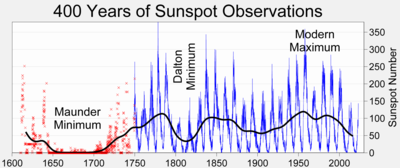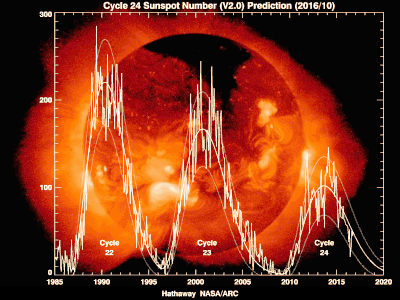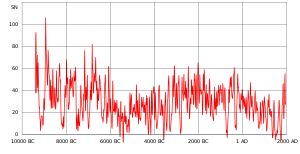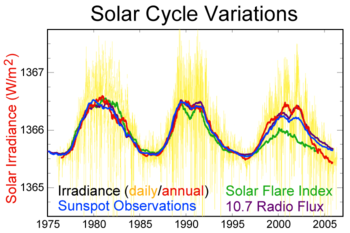From Wikipedia, the free encyclopedia
The Younger Dryas, from c. 12,900 to c. 11,700 calendar years ago (BP), was a sharp decline in temperature over most of the northern hemisphere, at the end of the Pleistocene epoch, immediately preceding the current warmer Holocene. It was the most recent and longest of several interruptions to the gradual warming of the Earth's climate since the severe Last Glacial Maximum, c. 27,000 to 24,000 calendar years BP. The change was relatively sudden, taking place in decades, and resulted in a decline of 2 to 6 degrees Celsius, advances of glaciers and drier conditions, over much of the temperate northern hemisphere. It is thought to have been caused by a decline in the strength of the Atlantic meridional overturning circulation, which transports warm water from the equator towards the North Pole, and which in turn is thought to have been caused by an influx of fresh cold water from North America into the Atlantic. The Younger Dryas was a period of climatic change, but the effects were complex and variable. In the southern hemisphere, and some areas of the north such as the south-eastern United States, there was a slight warming.[1]
The presence of a distinct cold period at the end of the Late Glacial interval has been known for a long time. Paleobotanical and lithostratigraphic studies of Swedish and Danish bog and lake sites, e.g. the Allerød clay pit in Denmark, first recognized and described the Younger Dryas.[2][3][4] The Younger Dryas is named after an indicator genus, the alpine-tundra wildflower Dryas octopetala. Leaves of Dryas octopetala are occasionally abundant in the Late Glacial, often minerogenic-rich, lake sediments of Scandinavian lakes.
The Younger Dryas is the youngest and longest of three stadials that resulted from typically abrupt climatic changes that took place over the last 16,000 calendar years.[5] Within the Byltt-Sernander classification of north European climatic phases, the prefix ‘Younger’ refers to the recognition that this original ‘Dryas’ period was preceded by a warmer stage, the Allerød oscillation, which in turn was preceded by the Older Dryas around 14,000 calendar years BP. This is not securely dated, and estimates vary by 400 years, but it is generally accepted that it lasted around 200 years. In northern Scotland the glaciers were thicker and more extensive than during the Younger Dryas.[6] The Older Dryas, in turn, is preceded by another warmer stage, the Bølling oscillation that separates it from a third and even older stadial. This stadial is often, but not always, known as the Oldest Dryas. The Oldest Dryas, occurred approximately 1,770 calendar years before the Younger Dryas and lasted about 400 calendar years. According to the GISP2 ice core from Greenland, the Oldest Dryas occurred between about 15,070 and 14,670 calendar years BP.[7]
In Ireland, the Younger Dryas has also been known as the Nahanagan Stadial, while in the United Kingdom it has been called the Loch Lomond Stadial.[8][9] In the Greenland Summit ice core chronology, the Younger Dryas corresponds to Greenland Stadial 1 (GS-1). The preceding Allerød warm period (interstadial) is subdivided into three events: Greenland Interstadial-1c to 1a (GI-1c to GI-1a).[10]
Abrupt climate change
Since 1916 and the onset and later refinement of pollen analytical techniques and a steadily growing number of pollen diagrams, palynologists have concluded that the Younger Dryas represented a distinct period of vegetational change in large parts of Europe during which warmer climate vegetation was replaced by generally cold climate – glacial plant succession that often contained Dryas octopetala. This drastic change in vegetation is typically interpreted to be an effect of a sudden decrease in (annual) temperature, unfavorable for the previously rapidly northward-spreading forest vegetation. This cooling not only favored the expansion of cold-tolerant, light-demanding plants and associated steppe fauna, it also led to regional glacial advances in Scandinavia and a lowering of the regional equilibrium line altitude (snow line).[2]The change to glacial conditions at the onset of the younger Dryas in the higher latitudes of the Northern Hemisphere between 12,900–11,500 BP in calendar years has been argued to have been quite abrupt.[11] in sharp contrast to the warming of the preceding Older Dryas interstadial. It has been inferred that its end occurred over a period of a decade or so,[12] but the onset may have been faster.[13] Thermally fractionated nitrogen and argon isotope data from Greenland ice core GISP2 indicate that the summit of Greenland was approximately 15 °C (27 °F) colder during the Younger Dryas[12] than today. In the UK, coleopteran (beetle) fossil evidence suggests that mean annual temperature dropped to −5 °C (23 °F),[14] and periglacial conditions prevailed in lowland areas, while icefields and glaciers formed in upland areas.[15] Nothing of the size, extent, or rapidity of this period of abrupt climate change has been experienced since its end.[11]
In addition to the Younger, Older, and Oldest dryases, a century-long period of colder climate similar to the Younger Dryas in abruptness has occurred within both the Bølling oscillation and the Allerød oscillation interstadials. The cold period, which occurred the Bølling oscillation, is known as the intra-Bølling cold period (ICBP) and the cold period, which occurred in the Allerød oscillation, is known as the intra-Allerød cold period (ICAP ). Both of these cold periods are comparable in duration and intensity with the Older Dyras and began and ended quite abruptly. These cold periods have been recognized in sequence and relative magnitude in paleoclimatic records from Greenland ice cores, European lacustrine sediments, Atlantic Ocean sediments, and Cariaco Basin, Venezuela.[16]
Examples of older Younger Dryas-like events have been reported from the ends, which are called terminations,[17] of older glacial periods. Temperature-sensitive lipids, long chain alkenones, found in lake and marine sediments are well-regarded as a powerful paleothermometer for the quantitative reconstruction of past continental climates.[18] The application of alkenone paleothermometers to high-resolution paleotemperature reconstructions of older glacial terminations have found that very similar Younger Dryas-like paleoclimatic oscillations occurred during Terminations II and IV. If so, then the Younger Dryas is not the unique paleoclimatic event, in terms of size, extent, and rapidity, as it has been often regarded to be.[18][19] Furthermore, paleoclimatologists and Quaternary geologists reported finding what they characterized as well-expressed Younger Dryas events in the Chinese (δ18O records of Termination III in stalagmites from high-altitude caves in Shennongjia area, Hubei Province, China.[20] Various paleoclimatic records from ice cores, deep sea sediments, speleothems, continental paleobotanical data, and loesses show similar abrupt climate events, which are consistent with Younger Dryas events, during the terminations of the last four glacial periods. They argue that Younger Dryas events might be an intrinsic feature of deglaciations that occur at the end of glacial periods.[20][21][22]
Timing of the Younger Dryas
During the early 1990s, it became obvious with an increasing number of high-resolution radiocarbon dates associated with the Younger Dryas that this distinct paleoclimatic period is very difficult to date in detail using radiocarbon dating. Radiocarbon dating of samples on either side of the Allerød–Younger Dryas Boundary yielded dates that exhibited a very rapid age shift. Typically, they jump from 11,000 radiocarbon years BP to 10,700–10,600 radiocarbon years BP at the boundary. The 11,000 radiocarbon years BP dates clearly pre-dates the boundary. The first (oldest) overlying Younger Dryas radiocarbon samples often yielded ages of 10,700–10,600 radiocarbon years BP without any evidence of either an intervening unconformity or other evidence of erosion or nondeposition. Radiocarbon dates of terrestrial macrofossils and tree rings in Europe show that this decline in apparent radiocarbon age occurred over about a 50-year period. For the Younger Dryas–Preboreal transition, high-resolution dating of identified plant macrofossils yielded dates that fall within so-called radiocarbon plateau, i.e., a 200–250 year long period when radiocarbon dating yields dates that are all roughly the same. As a result, the end of Younger Dryas can at best can only be estimated to have occurred sometime about 10,000–10,050 radiocarbon years BP.[2][23]The analyses of stable isotopes from Greenland ice cores provide a more precise estimate for the onset and end of the Younger Dryas period. The analysis of Greenland Summit ice cores as a part of the Greenland Ice Sheet Project-2 (GISP-2) and Greenland Icecore Project (GRIP) estimated that the Younger Dryas started about 12,800 ice (calendar) years BP. Depending on the specific ice core analysis consulted, the Younger Dryas is estimated to have lasted 1,150–1,300 years.[2][23] Measurements of oxygen isotopes from the GISP2 ice core suggest the ending of the Younger Dryas took place over just 40–50 years in three discrete steps, each lasting five years. Other proxy data, such as dust concentration, and snow accumulation, suggest an even more rapid transition, requiring about a 7 °C (13 °F) warming in just a few years.[11][12][24][25] Total warming in Greenland was 10 ± 4 °C (18 ± 7 °F).[26]
The end of the Younger Dryas has been dated to around 11.55 ka BP, occurring at 10 ka bp (uncalibrated radiocarbon year), a "radiocarbon plateau" by a variety of methods, with mostly consistent results:
11.50 ± 0.05 ka BP: GRIP ice core, Greenland[27] 11.53 + 0.04
− 0.06ka BP: Krakenes Lake, western Norway[28] 11.57 ka BP: Cariaco Basin core, Venezuela[29] 11.57 ka BP: German oak/pine dendrochronology[30] 11.64 ± 0.28 ka BP: GISP2 ice core, Greenland[24]
According to the analyses of varved sediments from Lake Suigetsu, Japan and other paleonenvironmental records from Asia, a substantial delay occurred in onset and end of the Younger Dryas between Asia and the North Atlantic. For example, paleoenvironmental analysis of sediment cores from Lake Suigetsu in Japan found the Younger Dryas temperature decline of 2–4 °C between 12,300 and 11,250 varve (calendar) years BP instead of about 12,900 calendar years BP in the North Atlantic region. In contrast, the abrupt shift in the radiocarbon signal from apparent radiocarbon dates of 11,000 radiocarbon years to radiocarbon dates of 10,700–10,600 radiocarbon years BP in terrestrial macrofossils and tree rings in Europe over a fifty-year period occurred at the same time in the varved sediments of Lake Suigetsu. However, this same shift in the radiocarbon signal predates the start of Younger Dryas at Lake Suigetsu by a few hundred years. Interpretations of data from Chinese also confirms the observation that the Younger Dryas dry and cold event in East Asia lags the North Atlantic Younger Dryas cooling with at least 200–300 years. Although, the interpretation of the data is more murky and ambiguous, it is likely that end of the Younger Dryas and start of Holocene warming was similarly delayed in time in Japan, and in other parts of East Asia.[32]
Similarly, an analysis of a stalagmite growing from a cave in Puerto Princesa Subterranean River National Park, Palawan, Philippines, found that the onset of the Younger Dryas was also delayed in that region. Proxy data recorded in the stalagmite indicated that it took more than 550 calendar years for Younger Dryas drought conditions to reach their full extent in the region, and about 450 calendar years to return to pre-Younger Dryas levels after it ended.[33]
Global effects
In western Europe and Greenland, the Younger Dryas is a well-defined synchronous cool period.[34] But cooling in the tropical North Atlantic may have preceded this by a few hundred years; South America shows a less well defined initiation but a sharp termination. The Antarctic Cold Reversal appears to have started a thousand years before the Younger Dryas, and has no clearly defined start or end; Peter Huybers has argued that there is fair confidence in the absence of the Younger Dryas in Antarctica, New Zealand and parts of Oceania.[35] Timing of the tropical counterpart to the Younger Dryas – the Deglaciation Climate Reversal (DCR) – is difficult to establish as low latitude ice core records generally lack independent dating over this interval. An example of this is the Sajama ice core (Bolivia), for which the timing of the DCR has been pinned to that of the GISP2 ice core record (central Greenland). Climatic change in the central Andes during the DCR, however, was significant and characterized by a shift to much wetter, and likely colder, conditions.[36] The magnitude and abruptness of these changes would suggest that low latitude climate did not respond passively during the YD/DCR.Effects in North America
In western North America it is likely that the effects of the Younger Dryas were less intense than in Europe; however, evidence of glacial re-advance[37] indicates Younger Dryas cooling occurred in the Pacific Northwest.Other effects
Other features include:- Replacement of forest in Scandinavia with glacial tundra (which is the habitat of the plant Dryas octopetala)
- Glaciation or increased snow in mountain ranges around the world
- Formation of solifluction layers and loess deposits in Northern Europe
- More dust in the atmosphere, originating from deserts in Asia
- Drought in the Levant, perhaps motivating the Natufian culture to develop agriculture
- The Huelmo/Mascardi Cold Reversal in the Southern Hemisphere ended at the same time
- Decline of the Clovis Culture and extinction of animal species in North America
Effects on agriculture
The Younger Dryas is often linked to the adoption of agriculture in the Levant.[38][39] It is argued that the cold and dry Younger Dryas lowered the carrying capacity of the area and forced the sedentary Early Natufian population into a more mobile subsistence pattern. Further climatic deterioration is thought to have brought about cereal cultivation. While there exists relative consensus regarding the role of the Younger Dryas in the changing subsistence patterns during the Natufian, its connection to the beginning of agriculture at the end of the period is still being debated.[40][41]Sea level
Based upon solid geological evidence, consisting largely of the analysis of numerous deep cores from coral reefs, variations in rates of sea level rise have been reconstructed for the postglacial period. For the early part of deglacial sea level rise, three major periods of accelerated sea level rise, called meltwater pulses, occurred. They are commonly called meltwater pulse 1A0 between 19,000 and 19,500 calendar years ago; meltwater pulse 1A between circa 14,600 and 14,300 calendar years ago; and meltwater pulse 1B between circa 11,400 and 11,100 calendar years ago. The Younger Dryas occurred after meltwater pulse 1A, which was a 13.5 m rise over about 290 years centered at about 14,200 calendar years ago and before meltwater pulse 1B, which was a 7.5 m rise over about 160 years centered at about 11,000 calendar years ago.[42][43][44] Between meltwater pulse 1A and meltwater pulse 1B, the Younger Dryas was an interval of a significantly reduced rate of sea level rise relative to the periods of time before and after it. For example, the analysis of cores from Tahiti coral reefs found that sea level rose at a rate of about 7.5 ± 1.1 mm/yr during the Younger Dryas. Just after the end of the Younger Dryas, the rate of sea level rise accelerated to 17.4 ± 0.4 mm/yr and just before its start, it was 12.1 ± 0.6 mm/yr. This reduction in the rate of sea level rise directly reflected a substantial reduction of the global inflow of meltwater into the world's oceans during the Younger Dryas.[42][45]Possible evidence of short-term sea level changes have been reported for the beginning of the Younger Dryas. First, the plotting of data by Bard and others suggested a small step, less than 6 m, in sea level near the onset of the Younger Dryas. There is also possibly a corresponding change in the rate of change of sea level rise that they saw in the data from both Barbados and Tahiti. Given that this change is …within the overall uncertainty of the approach…, it was concluded that a relatively smooth sea-level rise, with no significant accelerations occurred at this time.[45] Finally, research by Lohe and others in western Norway reported a sea-level low-stand at 13,640 calendar years ago and a subsequent Younger Dryas transgression starting at 13,080 calendar years ago. They concluded that the timing of the Allerød low-stand and the subsequent transgression were the result of increased regional loading of the crust and geoid changes caused by an expanding ice sheet that started growing and advancing in early Allerød about 13,600 calendar years ago and well before the start of the Younger Dryas.[46]
Causes
The prevailing theory is that the Younger Dryas was caused by significant reduction or shutdown of the North Atlantic "Conveyor", which circulates warm tropical waters northward, in response to a sudden influx of fresh water from Lake Agassiz and deglaciation in North America. Geological evidence for such an event is thus far lacking.[47] The global climate would then have become locked into the new state until freezing removed the fresh water "lid" from the north Atlantic Ocean. An alternative theory suggests instead that the jet stream shifted northward in response to the changing topographic forcing of the melting North American ice sheet, bringing more rain to the North Atlantic which freshened the ocean surface enough to slow the thermohaline circulation.[48] There is also some evidence that a solar flare may have been responsible for the megafaunal extinction, though it cannot explain the apparent variability in the extinction across all continents.[49]Impact hypothesis
A hypothesized Younger Dryas impact event, presumed to have occurred in North America around 12,900 calendar years ago, has been proposed as the mechanism to have initiated the Younger Dryas cooling. Amongst other things findings of melt-glass material in sediments in Pennsylvania, South Carolina, and Syria have been reported. These researchers argue that this material, which dates back nearly 13,000 calendar years ago, was formed at temperatures of 1,700 to 2,200 °C (3,100 to 4,000 °F) as the result of a bolide impact. They argue that these findings support the controversial Younger Dryas Boundary (YDB) hypothesis, that the bolide impact occurred at the onset of the Younger Dryas.[50] The hypothesis has been questioned by research that stated that most of the conclusions cannot be repeated by other scientists, misinterpretation of data, and the lack of confirmatory evidence.[51][52][53] After a review of the sediments that are found at the sites, new research found that sediments claimed, by the hypothesis proponents, to be deposits resulting from a bolide impact were, in fact, dated from much later or much earlier time periods than the proposed date of the cosmic impact. The researchers examined 29 sites that are commonly referenced to support the impact theory to determine if they can be geologically dated to around 13,000 calendar years ago. Crucially, only 3 of the sites actually date from that time.[54]In a study in the Journal of Geology (August 2014), Prof. Kennett (et al.) looked at the distribution of nanodiamonds produced during extraterrestrial collisions; 50 million square kilometers of Northern Hemisphere at YDB was found to have these nanodiamonds. Only two layers exist showing such nanodiamonds: the YDB 12,800 calendar years ago and the Cretaceous-Tertiary boundary 65 million years ago, which is also marked by the mass extinctions.[55]
“The evidence we present settles the debate about the existence of abundant YDB nanodiamonds,” Kennett said. “Our hypothesis challenges some existing paradigms within several disciplines, including impact dynamics, archaeology, paleontology, paleoceanography, and paleoclimatology, all affected by this relatively recent cosmic impact.”
Laacher See eruption hypothesis
Finally, it has been hypothesized that the eruption of Laacher See might have initiated the Younger Dryas stadial. Laacher See is a maar lake, a lake that lies within a broad, low-relief volcanic crater, that is about 2 km (1.2 mi) in diameter. It lies in Rhineland-Palatinate, Germany, about 24 km (15 mi) northwest of Koblenz and 37 km (23 mi) south of Bonn. This maar lake lies within the Eifel mountain range, and is part of the East Eifel volcanic field within the larger Vulkaneifel. The East Eifel volcanic field has been active since about 400-11 calendar years ago.[56][57] The maar, which this lake occupies is the result of phreatic and phreatomagmatic eruptions as well as caldera collapse processes. Phreato-plinian eruption sent plumes of phonolitic to mafic phonolitic tephra over the region and pyroclastic flows and surges over the local countryside in predominantly in northeastern and southern directions. This eruption was of sufficient size, VEI 6, with over 10 km3 (2.4 cu mi) tephra ejected, to have caused significant temperature changes in the northern hemisphere.[58][59]However, there are problems with the hypothesis that the eruption of Laacher see volcano initiated the Younger Dryas. First, detailed dating of varved and other lake deposits in other maar lakes determined an age of at least 11,230 ± 40 radiocarbon years BP for the Laacher See eruption. This radiocarbon age would make the Laacher see eruption about 200 radiocarbon years older than the start of the Younger Dryas.[60] More recently, the radiocarbon dating of trees killed by the Laacher See eruption and an examination of Swiss dendrochronology and volcanic sulphur in the Greenland ice cores concluded that the Laacher See eruption predated the onset of the Younger Dryas by some 203 calendar years on average.[61] Second, Late-Glacial sediment cores from Switzerland demonstrate that a significant period of time separate the Laacher See eruption and the start of the Younger Dryas.[60][62][63] Finally, Even if the Laacher See eruption was contemporaneous with the start of the Younger Dryas, as big as it was, the size of the Laacher see eruption was likely not large enough to initiate a new stadial. The paleoclimatic proxies found in Greenland ice cores show only a short-term climatic deterioration associated with the Laacher See eruption.[61][64]















